by scott.gillum | Jun 10, 2013 | 2013, Marketing
 This time of year, America’s third or fourth (depending on where you live) most popular sport gets its moment in the sun. The Stanley Cup finals begin this week and the nation’s attention turns to ice, hockey sticks, pucks, and maybe mullets.
This time of year, America’s third or fourth (depending on where you live) most popular sport gets its moment in the sun. The Stanley Cup finals begin this week and the nation’s attention turns to ice, hockey sticks, pucks, and maybe mullets.
For business marketers, the “holy grail,” or in this case the “Stanley Cup,” has been trying to demonstrate the business impact of social media. Not defined by adoption, usage, or engagement, but by influence. Proving that social media and/or social networks can influence buyer behavior. New insight suggests that it might be time to lace up the skates and put on the pads.
Word of mouth (WOM), defined by person-to-person communication be that in person or over the phone, is and has always been the most used, and most influential channel for business buyers. Sometimes also described and measured as NPS (Net Promoter Score), it is the “Wayne Gretsky” of driving influence among decision makers, both in new acquisition, and for renewal.
Unlike WOM, Social Media has struggled with demonstrating influence. Adoption and usage rates continue to grow, but the impact on B2B decision makers has been difficult to nearly impossible to measure (btw – this is not unlike other, more established media channels).
That was until now. Research from Buyersphere may give us a clue to how social media may influence decision makers in the near future, and it has given us a couple of “hockey sticks” and a “puck” to play with.
According to Buyersphere’s Annual Survey of B2B Buyer Behavior, even though buyers mention social media (and providers such as Twitter, Facebook and Linkedin) when asked to rate their usage and the usefulness of channels when searching for vendors, they fall off the grid when asked to evaluate their influence. As you would expect, word of mouth came out on top.
Diving deeper into the research, it revealed a few game changing findings. Twenty to thirty year olds (Gen Y), act like no other previous generations. The first “hockey stick” is somewhat known — twenty-something business buyers are roughly twice as likely to seek information or advice from social media as the generation before them (31-40 year olds). And almost four times more likely to than the baby boomers (51-60 year olds).
 The second hockey stick, and the one that may end up being somewhat problematic for marketers, is that 49% of Millennials stated that they wanted to create and publish their own professional content. They not only want your content, but they also want to be able to disassemble it and repackage it with their own point of view.
The second hockey stick, and the one that may end up being somewhat problematic for marketers, is that 49% of Millennials stated that they wanted to create and publish their own professional content. They not only want your content, but they also want to be able to disassemble it and repackage it with their own point of view.
And finally, the puck to play with is that buyers under 30 are the only group that describe word of mouth as social media first, and then phone or in person. Close to 50% of Gen Y buyers defined WOM as any social media, in person or phone, mentioned by only 33% of the respondents. Buyers 40-50 by contrast, define WOM as in person or phone 60% of the time with any social media platform only 23%.
Game On
Marketers most powerful and influential channel is now being redefined, and this presents the best opportunity to date to demonstrate the impact of social media on buyer behavior. “To skate to where the puck is going to be” as Gresky used to say, we need to plan now.
To define the approach we need to understand the components of “social media” that are often lumped together – social networks and social media. Social networks refer to the connection among users and their social structure (friend, business acquaintance, etc.).
Social media is defined as the online channel used to generate, access and distribute content. The distinction is important because of the way different generations of business buyers use and value them. This is key to unlocking influence.
We know that their social network heavily influences Gen Y, more than any other generation. We know that half of them want to produce and share their own content, 60% upload content to the web, and 62% rate products and services on the web.
So for Enterprise accounts, where Gen Y is 5-10 years from occupying the C-Suite, take a lesson from McDonalds and “grow your own customers.” Get Gen Y hooked on your content by involving them in your brand and making your content modular so it’s easy to repackage and share. The route to influence is through cause marketing efforts delivered via mobile devices. Thirty-seven percent of Millennials say they are drawn to products with co-branded campaigns.
For small businesses, which Gen Y owns close to 1 out of 3, according to the Executive Council of Small Business (ECSB), the goal should be to make them advocate for your brand, product or services to their network. To do that, focus on issue resolution, the number one loyalty driver. For prospects, provide them with information that is useful.
According to the ECSB, the number one pain point for all small business owners is sales and customer acquisition; being twice as prevalent among Gen Y owners. Specifically, lead generation and successfully competing with other small business owners. Help them understand how your products and services can help them grow their business.
Even though there is potential for social media to deliver a real, tangible business impact, it will be similar to this championship series. It’s not going to be quick, expect to lose a game or two along the way, and to be successful you’ll need to take many shots on goal…hell, you may even lose a tooth or get a “shiner.”
by scott.gillum | May 12, 2013 | 2013, Sales
John Wanamaker was an innovator, a merchandising, and advertising genius. But when he made the statement; “Half the money I spend on advertising is wasted, the trouble is wasted, the trouble is I don’t know which half.” He left legacy that has haunted marketers ever since.
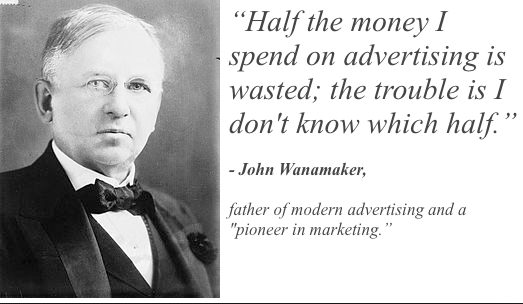
New research from CSO Insights suggests that the day may have come for sales. In their annual Sales Performance Optimization study of over 1500 companies across multiple industries, CSO found that the accuracy of sales forecasting fell to a near all-time low of 46.5%. Or as John Wanamaker might say; “Half of your sales efforts are wasted, you just don’t know which half. “
And since the forecast, defined in the study as near-term (30, 60 and 90 day), is an output of the sales pipeline, one could also conclude that half (or more) of the pipeline is “junk.”
With the wide spread adoption and utilization of CRM (84% of the firms surveyed), marketing automation, and analytical forecasting tools, the question is how can this be?
Here are some thoughts on why this might be happening, and five tips to help you improve your forecast.
Reasons for poor forecasting:
- Impurities in the System – let’s go after the big one first. “Garbage in, garbage out”…as they say. There’s a laundry list of things to look for — from reps putting leads in the system right before they close, to not updating opportunity consistently, and leaving in dead leads too long.
- Sales Optimism – yes, the economy seems to be recovering but it may not be moving at the “speed of sales.” Sales folks are an optimistic bunch; they want to believe things are better than they may be in reality. For example, the average length of the sales cycle. In a report earlier this year by BtoB Magazine, 43% of marketers reported that the sales cycle had increased over the last 3 years. Which is consistent with the CSO Insights report where 42% of Chief Sales Officers stated that the sales cycle had lengthened, in particular with new acquisitions.
- Incentives & Goals – take a look at how reps are being incented, and/or their sales goals. You may find the reason why reps leave opportunities in the pipeline too long, and/or are over optimistic with their forecast. Pressure to build and maintain pipeline can sometimes cause counter productive behaviors.
- Gut Feel – even if the troops in the trenches are putting in accurate and timely data, the generals may change it to fit the political environment and/or their own personal bias.
- Changing Buyer Behavior – recent research has shown that the buyer’s journey, and the typical sales process are not aligned. Buyers frequently start and stop the journey, or will cycle at a stage, and even move backward in the process. CRM systems are typically designed in a linear approach, progressing from a lead to a close. It’s an internal view, and increasingly out of alignment with buyers’ preferences.
How to improve:
- Active Pipeline Management – The pipeline and forecast will never be 100% accurate. That said, you should have a feel for how far off it is, and what is needed to improve. For example, do you have an inspection process to keep the pipeline current? If so, consider doing it more frequently. Move quarterly reviews to monthly. Also, if everyone is responsible for updating the pipeline, then no one is responsible. Consolidate the “maintenance and hygiene” of the pipeline to one person. Others may be responsible for providing updates, but one person needs to police the system.
- Discount Probability and Value – conduct a post-mortem on past forecasts over last year or two. Assess the difference between forecasted and actual results. Create discounted probabilities based on that delta for: lead movement (from stage to stage), and lead value. If implemented, evaluate the accuracy of your “pre-set” discounts. It should help bring forecasts more in-line and ground “sales optimism” in a bit of reality.
- Govern the Process – to improve the accuracy of “output”, focus on implementing and managing a standard process. Accenture’s Connecting the Dots on Sales Performance found inconsistencies among reps in using their company’s defined process and methodologies to selling. A quarter of Chief Sales Officers surveyed stated that sales reps used their sales methodologies 50% of the time, 31% said it was used 75% of the time.
- Leverage Marketing – close the feedback loop with marketing to improve the quality of leads from campaigns and activities. In a report on Sales & Marketing Alignment by the Aberdeen Group, marketing accounted for 47% of the sales forecasted pipeline in the Top 20% of companies studied, compared to only 5% of laggard organizations (bottom 20%).
- Utilize Business Intelligence Tools – high penetration rates of CRM may equate to high visibility, but doesn’t automatically mean that it provides the best insight. Despite high adoption rates of performance dashboard, few companies are using business intelligence or analytics tools according to the Aberdeen Group report on sales forecasting. However, the report found that 44% of the highest performing sales organizations were using predictive analytics to reduce “gut feel” in the forecast.
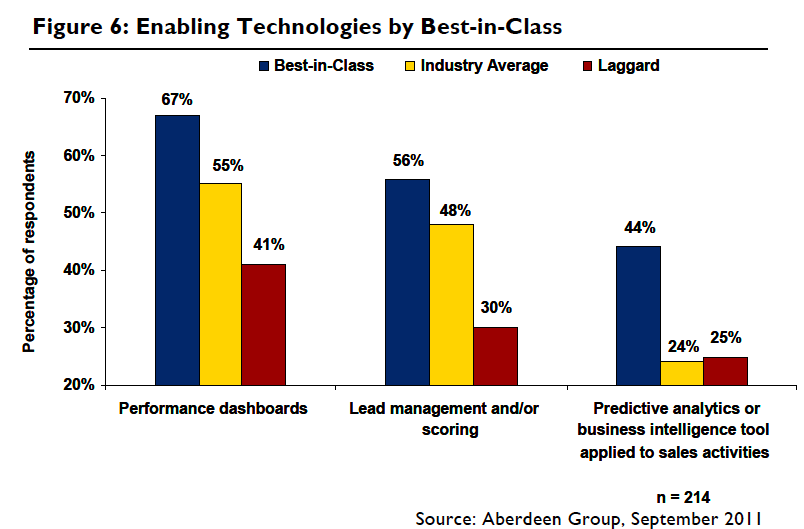
Of all the options, perhaps the best lever for impacting accuracy is the rep. As Ashish Vazirani, a Principal in the Hi-Tech practice of the sales consultancy, ZS Associates says; “A sales person needs to be coached, or apprenticed on how to discern and input the right information for accurate forecasting. Technology can make us lazy and reliant on the tools to do the thinking, we need to emphasize the importance coaching plays in keeping the garbage out of the system. ”
Helping the troops become better soldiers through coaching should help improve the accuracy of the forecast. As well as, implementing the tips mentioned above. But you may still find that half of the pipeline is wasted, but hopefully, unlike Mr. Wanamaker, you’ll understand which half.
by scott.gillum | Apr 18, 2013 | 2013
I grew up in a factory town, a community of craftsman. At 15, my grandfather watched as they built the factory where he would work for fifty years. On the day it opened he got a job working on the assembly line. At its peak, it employed 10,000 people.
During that time, the town grew and merchants prospered. But as production at the factories slowed and the work moved overseas, the merchants began to feel the impact, and when the big box retailers rolled in, it killed them. By my teens, the new reality was high unemployment, vacant storefronts, and the once thriving downtown shopping area was now a ghost town.
Started in Brooklyn in 2005, Etsy was the idea of Robert Kalin, Chris Maguire, and Haim Schoppik, who modeled it after open craft fairs. In an article in Wired magazine writer Rob Walker described Kalin’s vision as “a cultural movement that could revive the power and voice of the individual against the depersonalized landscape of big box retail.”
The site was originally designed to be an e-commerce platform for handmade items, on the belief that hand crafted items had “an intrinsic value” that should be given a forum outside of traditional retail. Etsy has since modified its policies to include designers of goods, and curators of vintage goods (20 years or older).
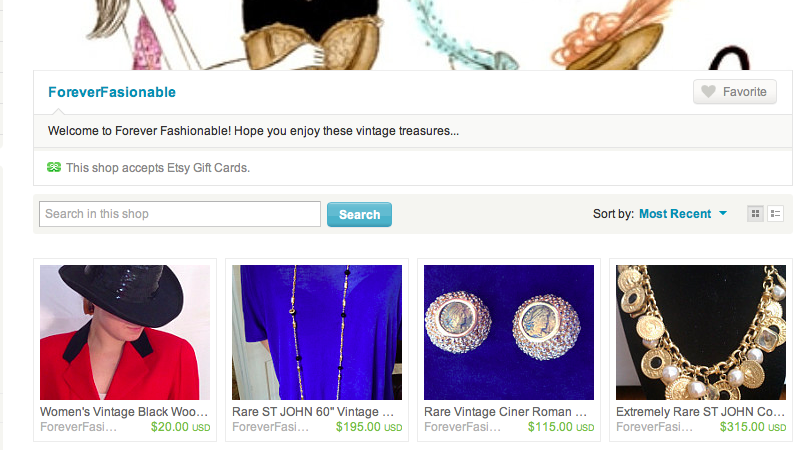
Example Vintage Shop – Forever Fashionable
It provides users (shop owners) a virtual storefront on the internet for a small fee of $0.20 per listed item. Providing global scale for small shop owners who design, build, or curate items such as art, jewelry and other handcrafted items.
Unlike the Fancy or Ebay, Etsy puts the focus on their shop owners, which now number 800,000. Visitors can read shop owner’s profiles, follow them, and see the items and shops they favor. Perhaps most interesting is the video series Etsy has created to tell the stories of it craftsman and curators, celebrating their passions, interest and ambitions.

Example Shop Owner Video
Etsy now enters an interesting time in its rapid rise. In order to scale to the next level, it must wrestle with the challenge that handmade items also come with production limitations. As the site tries to stay true to its founding vision of handcrafted items, it has loosened the rules to allowing for the option of “remote employees.”
It now acknowledges that not every designer actually has the desire and/or capability to build what he or she designs, permitting production to be outsourced to someone else.
Perhaps the most shocking change is that Etsy is piloting integrating into mainstream retail through an arrangement with West Elm (owned by Williams Sonoma) that would bring Etsy merchant’s products to the shelves of the nationwide chain.
For now, Etsy won’t put big box retailers out of business any time soon, but given the current state of retail it may be an evolution that is much needed. With the evolution of ecommerce and the rise of big box retailers also came the coldness of impersonal transactions.
Etsy offers its 25 million members the opportunity to develop a relationship with shop owners, to become an admirer of their work and/or appreciate their eye for style. A chance to do business on a personal level again, with someone they know, and/or share a similar interest or passion.
And as a result, it changes the buying experience from one of procuring an item because of the functionality or utility, to one of investing in the uniqueness of the idea that originated it, and in the skill of the craftsman that produced it.
Etsy offers all the things you loved about doing business with a small proprietor or craftsman in your local community without the geographic limitations. It’s an opportunity to reconnect to humanity and to the small merchants that built the downtown you knew as a kid.
by scott.gillum | Apr 7, 2013 | 2013, Opinion
Why do we do it? No one is forcing us. As Christopher McDougall points out in his brilliant book, Born to Run, we no longer need to chase down our food. So why do we do something physically and mentally challenging, and occasionally painful, if we don’t have to. Why not just take it easy?

This was the conversation inside my head early this weekend before the Cherry Blossum 10 Mile run in the Nation’s Capital. In fact, it’s the same conversation I have before any race. Why would anyone in their right mind stress themselves out for a week and get out of bed at 5:30 am on a weekend to run.
I spent the first 2-3 miles of the race observing people trying to answer that question. From what I saw, some folks run to challenge themselves, some run for others, like the a guy in a yellow kilt running for fallen combat soldiers, the woman with a picture of her deceased cat on her shirt, and of course, the group of sickos who do it because they actually enjoy it.
Me? Well, I’m another story. It’s taken me many years, several races, and 10 miles this weekend to figure it out. The truth is, I hate to run. It’s a means to an end. I like to race, but I hate to run. It’s a legacy of growing up playing sports, where running was a “have to” and not a “want to.”
Up until my 40th birthday, I had successfully avoided running, while slowly turning myself into a “fat and happy” sedimentary “couch” potato. That was until a colleague of mine issued the challenge of doing a sprint triathlon as a way for us to celebrate our 40th birthday (thank you Patrick).
Since that time, I train regularly and do various types of endurance races. Along the way, I dropped the 25 lb. bag of potatoes. I’ve gotten into a routine of training, but I hadn’t totally figured out why I continue to do races until this weekend. Alone with my thoughts for the next hour and half or so, I committed to figuring it out.
I know that I need to pick events that give purpose to my training routine. But the epiphany came at mile 5 when I realized that I think I actually like to scare myself to remind me not to become complicit and/or too comfortable again. My approach is to pick events I’ve never done, and to usually do them alone, because it heightens the fear factor.
The days and night before the race is spent stressing myself out about the course layout, logistics, and perhaps, most importantly, the locations of bathrooms. But along with the fear and the stress, I know there is also the heightened sense of accomplishment.
By mile 9, I realized that this habit had spilled over to my work life. I left a comfortable position three years ago to enter a new industry, and to start a new business with gyro. I “had it good,” but I decided shake things up, I had become in a sense “fat and happy” in my career.
Like training, we can easily fall into the “habit” of just going to work everyday. In fact, some probably dislike it as much as I dislike running. And I wonder if that might be because our work life sometimes lacks that “event” to give it purpose. It’s easy to fall into a routine and become comfortable. Life itself can be complicated, so why make it more difficult?
Perhaps a big, fat scary goal is what is needed give greater meaning to our work, and to reenergize us. With that fear of the unknown, and/or the unaccomplished, also comes the reminder of what it is to be alive.
Yes, it can be painful and uncomfortable, like how my lower back and calves feel as I write this, but you may also be pleasantly surprised. A sense of accomplishment can fuel the need to set bigger, more challenging ways to push yourself, becoming a habit. So, if you get a chance to be alone with your thoughts, ask yourself “why do you run?”
by scott.gillum | Mar 13, 2013 | 2013
I joined gyro in 2010. At that time we were called GyroHSR, and were a collection of 9 small to mid-size agencies from around the world that were part of a roll-up. We didn’t share a common language, system or culture. What held us together was a vision of being the world’s best B2B agency.
The first year was challenging. I came into the ad business from the outside. My experience had been consulting and marketing services. I naively thought it would be an easy transition, that my world and this world weren’t that far apart. I was wrong. Everything seemed to have a learning curve, I spoke a different language and the other side of my brain, long neglected, needed to be developed.

Over the next two years almost everything would change. We dropped the “HSR” and became known solely as gyro. Our investors brought in a new management team and our new CEO & Chief Creative Officer, Christoph Becker would completely remake our creative teams across the network. But most importantly, Christoph would change our culture, our language and our focus. And along the way, the right side of my brain began to develop.
During this time, we undertook two intiatives that I think have set us up for the success that we are enjoying today. The first, was that we believed that “b2b marketing” as we knew it, was “dead”. Targeting a business buyer by a title, at a business address, during business hours, was an antiquated concept. We would later prove that to be the case with our @Work State of Mind research conducted with academic institutions and Forbes (click here for the research report).
The second was that ideas needed to be “humanly relevant”. That behind every business decision maker was a person, and that person made decisions based on emotions. Our research would show that the buyers journey was, in fact, a very rational process up until the point of the decision…and then emotions took over.
It became easy to differentiate ourselves from competitors, and clients/prospects believed in what we preaching. As the wins starting coming, our culture started to align around what we call UNO. One language, one process, one culture, we became unified across the network. Client teams from across the world began working together to deliver the best ideas and outputs, regardless of the location. Our work starting winning awards, and the world started to notice.
What’s different about BtoB magazine award today, isn’t necessarily that we’ve been recognized, gyro has won awards in the past. But rather it’s an external validation point that we are on the right path, and the hard work is paying off. We won in the “Large” agency category (our first year in that category), going up against the “best of the best,” like Ogilvy. It’s a litmus test that our vision of being the best B2B agency in the world, and the reason why most of us joined gyro, is being realized, at least in the U.S…and at least for this year.
We not done yet, we still have work to do and clients to dazzle, but for now…we’re Numero UNO, and it feels good.
by scott.gillum | Feb 19, 2013 | 2013, Marketing
You know the question is coming, because it comes every year. You know who is going to ask it, because they ask it every year. It’s just a matter of when, perhaps at the end of a difficult quarter, or during a mid-year review meeting. As budgets are being discussed it comes; “What are we getting from our marketing dollars?”
It’s a fair question to ask, and given the size of some marketing budgets, marketers should be asking the same question. To answer the sales executive (usually the one asking the question) you must first recognize what they are really asking, which is; “what is the value of marketing to them?” Specifically, they want to know the impact marketing is having on sales performance, beyond leads.
A few years ago, we did some interesting research for a medical equipment manufacturer. Their analysis showed that they were missing opportunities but they couldn’t agree on why – was it a sales or marketing issue?
To uncover the answer we interviewed hundreds of buyers (customers and prospects) in order to rate the performance of the company compared to three competitors, at four stages of the pipeline, product awareness (unaided), consideration, proposal and win. We then constructed a quantitative model to reflect the impact of changes in performance. Two years later, we were given a unique opportunity to measure the impact of recommendations and investments.
The research yielded three key insights on the importance of marketing and how it was impacting their sales success:
1. Increasing Opportunities – without marketing support sales cannot move consideration rates. The company’s unaided product awareness rate was 62%, compared to 88% for the market share leader. The consideration rate was even worse at 46% compared to 86% for the leading competitor.
The organization had a strong sales culture. So to demonstrate the need to increase marketing activity, and not just sales coverage, we included “relationship with the sales team” as a key consideration drive, along with typical drivers such as; price, brand, and service.
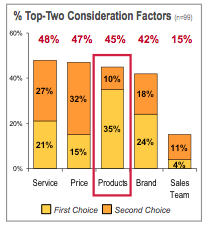
The research showed that the relationship with the sales team was not an important consideration driver. In fact, the data revealed that reps could do very little to change buyers’ perceptions relating to products and service. It also revealed a new buyer that was not being reached by the sales force.
The company increased the marketing budget and reallocated funds from events into digital marketing. They ramped up webcast, videos and built a microsite specifically for this new buyer. As a result, Awareness rose 17 percentage points to 79%, and Consideration, originally at 46% rose to 62%. The model showed that an incremental 1% change in consideration rates yielded 20 new opportunities, and almost four new wins with a value of almost $2M.
2. Sales Coverage – increased marketing activity can create the perception of greater sales coverage. Buyers were asked how often they saw a sales person within a 90 day period. They mentioned seeing the company reps on average of 0.8 times, basically once a quarter, while reporting rep visits from the leading competitor at 2.5 times, almost once a month. Two years later, buyers stated seeing the company’s reps 2.4 times per quarter, on par with competitors. As a result of the ramped up marketing efforts, buyers perceived an increase in visits despite the fact that the number of reps in the segment remained the same over the two year period.
3. Sales Enablement – marketing can identify shifts in buying behavior. The company’s performance had increased in all stages of the funnel except for one, existing accounts Reps had mentioned that customers had become more “price sensitive” and competitors were undercutting them. The company was the product leader in the industry and the senior management team still believed that technology innovation was the key consideration driver.
The follow up research found that the sales force was indeed right. Buyers had shifted their priorities. With changes in reimbursement, healthcare reform, and an effective competitor campaign against overbuying technology, buyers had indeed changed, much faster than anyone suspected.
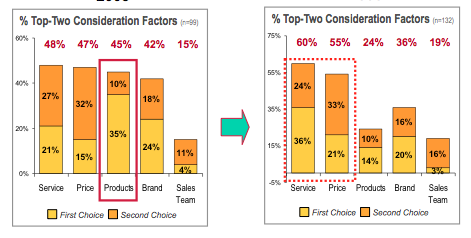
As a result, sales material and value proposition had to be updated quickly. Instead of espousing the virtues of innovation, it now needed to help buyers justify the investment. Leading to a shift from “bells and whistles” to “ROI models and product configurators.”
So, how do you communicate the impact marketing has on sales performance? Tell the sales folks that marketing can identify new buyers and influencers, increase the number of opportunities reps see, improve a buyers perception of sales coverage, and enable them with the right value proposition at the right time to win the deal. Of course, you’ll need the data to prove it.
In this case, the increased marketing investment and activities yielded $50 million in new sales over the two-year period…just as the model predicted.
 This time of year, America’s third or fourth (depending on where you live) most popular sport gets its moment in the sun. The Stanley Cup finals begin this week and the nation’s attention turns to ice, hockey sticks, pucks, and maybe mullets.
This time of year, America’s third or fourth (depending on where you live) most popular sport gets its moment in the sun. The Stanley Cup finals begin this week and the nation’s attention turns to ice, hockey sticks, pucks, and maybe mullets. The second hockey stick, and the one that may end up being somewhat problematic for marketers, is that 49% of Millennials stated that they wanted to create and publish their own professional content. They not only want your content, but they also want to be able to disassemble it and repackage it with their own point of view.
The second hockey stick, and the one that may end up being somewhat problematic for marketers, is that 49% of Millennials stated that they wanted to create and publish their own professional content. They not only want your content, but they also want to be able to disassemble it and repackage it with their own point of view.













